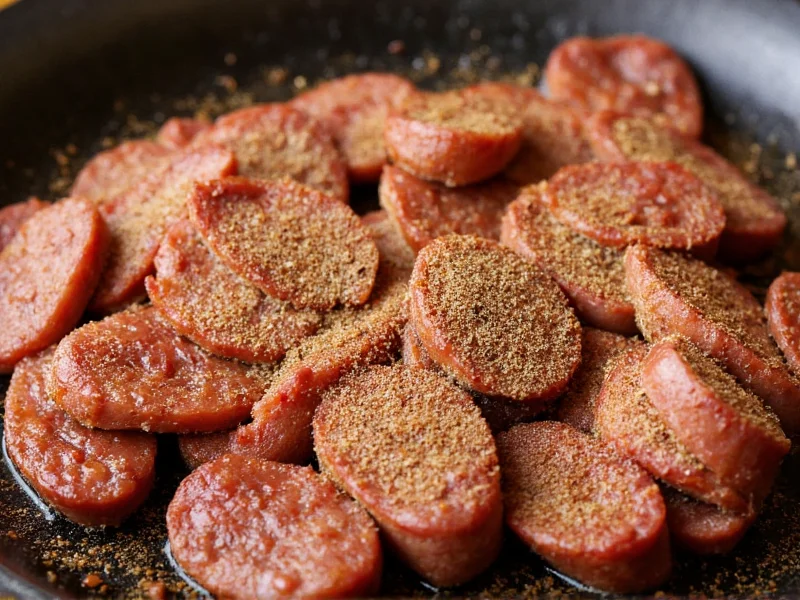Understanding which spices complement pork transforms ordinary meals into extraordinary culinary experiences. Pork's versatile flavor profile—mild yet rich with natural sweetness—pairs beautifully with both robust and delicate seasonings. The right spice selection enhances rather than overwhelms pork's inherent qualities, creating balanced dishes that satisfy the palate. This guide explores scientifically backed flavor pairings, regional traditions, and practical application techniques for perfect pork seasoning every time.
The Science Behind Pork and Spice Pairing
Pork contains high levels of glutamates and inosinates, compounds that interact favorably with certain aromatic compounds found in spices. These chemical interactions create what food scientists call 'flavor synergy'—where the combined effect exceeds the sum of individual components. For instance, the thymol in thyme binds with pork's fat molecules, releasing complex aromas during cooking that wouldn't occur with either component alone.
Understanding pork cuts matters significantly when selecting spices. Lean cuts like tenderloin benefit from moisture-retaining herbs like rosemary, while fatty cuts like pork shoulder can handle bolder spices such as cumin and smoked paprika that cut through richness. This knowledge helps home cooks make informed decisions about what spices go well with pork chops versus other cuts.
Top 10 Spices for Pork and How to Use Them
| Spice | Best For | Recommended Form | Usage Tip |
|---|---|---|---|
| Sage | Pork chops, sausages | Fresh leaves | Add early in cooking to mellow sharpness |
| Garlic | All pork cuts | Minced fresh | Combine with rosemary for classic pairing |
| Black Pepper | Roasts, grilled pork | Coarsely ground | Use with salt in 3:1 ratio for optimal seasoning |
| Cumin | Pork shoulder, carnitas | Ground | Bloom in oil before adding pork |
| Fennel Seeds | Sausages, belly | Whole or cracked | Dry toast before use for enhanced aroma |
Regional Spice Traditions for Pork Dishes
Cultures worldwide have developed distinctive spice combinations for pork based on centuries of culinary evolution. Chinese cuisine features the famous five-spice powder (star anise, cloves, Chinese cinnamon, Sichuan pepper, and fennel seeds), creating complex sweet-savory profiles perfect for pork spice rub recipes. In Mediterranean cooking, rosemary and garlic form the foundation of many pork preparations, while Mexican cuisine utilizes chili powder, cumin, and oregano for vibrant carnitas and al pastor.
German culinary tradition pairs pork with juniper berries and caraway, particularly in sauerbraten preparations. These regional approaches demonstrate how spice combinations for pork reflect local ingredients and historical influences. Understanding these traditions helps cooks create authentic dishes while providing inspiration for innovative flavor experiments.
Matching Spices to Specific Pork Cuts
Not all pork cuts respond equally to the same seasonings. This section addresses the critical question of which spices pair well with pork belly versus other cuts:
- Pork loin: Benefits from delicate herbs like thyme and marjoram that won't overpower its mild flavor
- Pork shoulder: Handles robust spices like cumin, chili powder, and smoked paprika ideal for slow cooking
- Pork belly: Pairs exceptionally with five-spice powder, star anise, and Szechuan peppercorns that cut through richness
- Tenderloin: Works best with subtle seasonings like garlic powder, onion powder, and a touch of mustard powder
Creating Balanced Spice Rubs for Pork
Effective spice rubs follow a simple formula: 40% salt, 30% sweet element, 20% heat, and 10% aromatic. For example, a classic pork rub might contain:
- ¼ cup brown sugar (sweet element)
- 2 tbsp kosher salt
- 1 tbsp smoked paprika (heat)
- 1 tbsp garlic powder
- 1 tsp black pepper
- 1 tsp dried thyme (aromatic)
When applying rubs, massage the mixture into the meat's surface, paying special attention to any crevices. For best results with how to season pork for grilling, apply the rub at least 1 hour before cooking, or ideally 12-24 hours for deeper flavor penetration. Remember that sugar-based rubs will caramelize quickly, so monitor cooking temperatures carefully.
Common Seasoning Mistakes to Avoid
Even experienced cooks make errors when seasoning pork. The most frequent issues include:
- Over-salting lean cuts, causing dryness
- Adding delicate herbs too early in cooking, burning their volatile oils
- Using pre-ground spices that have lost potency
- Ignoring the importance of acid components (like citrus or vinegar) that balance richness
- Mixing too many competing spices that create flavor confusion
For optimal results with traditional spices for roasted pork, select 2-3 complementary spices rather than overwhelming the dish with numerous competing flavors. Remember that pork's natural sweetness means it pairs exceptionally well with warm spices like cinnamon and allspice in moderation.
Storing Spices for Maximum Flavor Impact
Freshness dramatically affects how well spices work with pork. Ground spices retain peak flavor for 6-12 months, while whole spices last 1-2 years. Store spices in airtight containers away from heat and light. For critical applications like best spices to use with pork loin, consider grinding whole spices just before use—this releases maximum volatile compounds that interact beautifully with pork's fat content.











 浙公网安备
33010002000092号
浙公网安备
33010002000092号 浙B2-20120091-4
浙B2-20120091-4